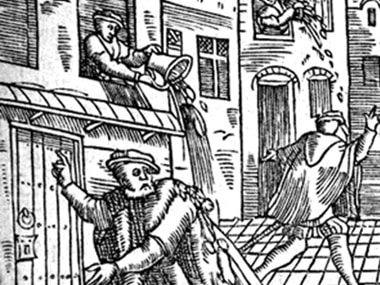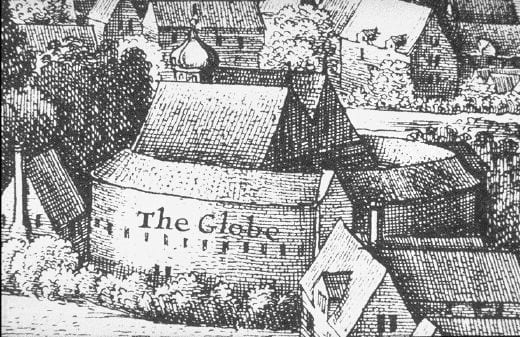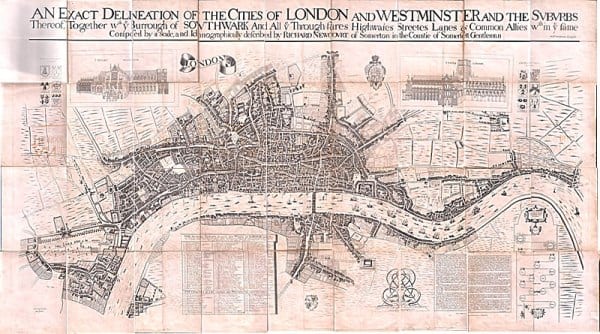Interested in the Shakespeare-London connection? Then read on… Although Shakespeare is known as the Bard of Avon, and came from Stratford, Shakespeare and London are inextricably linked.
In the article, we present 21 facts about Shakespeare’s London in the late 16th century and early 17th century that the Bard would have known and experienced. (See 55 Shakespeare facts for broader insights into his life.)
Shakespeare London Facts
Shakespeare London Fact 1
Most ordinary Elizabethan Londoners lived in apartment buildings that were squashed together haphazardly, without planning. London began to develop suburbs during this time. Some courtiers and other wealthy Londoners built themselves country residences around the edges of London in areas that later became part of what we know as London today.
Shakespeare London Fact 2
People emptied their chamber pots and refuse from their windows and rain washed the waste into the river from dung piles, ditches, cesspits and streams.

Watch out above!
Shakespeare London Fact 3
Shakespeare left Stratford in 1587 and went to London. The first record of William Shakespeare in London is of him living in Bishopsgate in 1596 (see our post on where Shakespeare lived in London). The address is unknown is thought to be in the vicinity of Leadenhall Street and St Mary Avenue.
Shakespeare London Fact 4
It is not known how long Shakespeare resided in Bishopsgate but he was definitely living in the parish of St Helens, as according to the parish records he was assessed on goods valued at £5 and taxed 5 shillings.
Shakespeare London Fact 5
In 1598 Shakespeare was lodging somewhere in the tiny area known as ‘the Liberty of the Clink’ which surrounded the notorious prison of that name. The location was within a minute’s walk of the building site that was to become the Globe Theatre (a project close to Shakespeare’s heart as he was a shareholder in the company).
Shakespeare London Fact 6
In 1604 Shakespeare was living in Silver Street, St Pauls, in an upstairs room in the house of the Mountjoys, a French Huguenot family.
Shakespeare London Fact 7
The population of London had risen to 200,000 by 1600 and the city was evolving as the multicultural city that it is today. There was a Jewish community in Bishopsgate and a few thousand black people – mostly servants, musicians, and dancers. There were also many Huguenot and Flemish refugees.
Shakespeare London Fact 8
In 1613 Shakespeare bought a a house known as The Gatehouse, on the north eastern corner of the large Blackfriars Theatre site. He bought the house from Henry Walker for £140 but never lived there. Shakespeare left The Gatehouse to his daughter Suzanna. The Cockpit pub was built on the site of Shakespeare’s Gatehouse, and is still a working pub.
Shakespeare London Fact 9
London Bridge was the only bridge that connected the northern and southern sides of Elizabethan London, and Shakespeare would likley have walked across London Bridge several times a week. Well-off Elizabethan commuters hired ferrymen to ferry them across and along the Thames.
Shakespeare London Fact 10
As Shakespeare crossed London Bridge the impaled heads of executed traitors would have been a common sight, reminding him to be careful about becoming involved in politics.

Shakespeare’s London Bridge image©www.3dartvision.co.uk
Shakespeare London Fact 11
The Thames was crowded with rowing boats, barges, and commercial sailing ships. There were no embankments on the Thames and the river would regularly overflow its banks during the spring and flood much of London. In winters the Thames frequently froze, and people would fix animal bones to their shoes and skate on the ice. Vendors would set up their stalls to take the advantage of the many people who crowded on to the frozen river.
Shakespeare London Fact 12
Shakespeare would almost certainly have visited the Royal Exchange on Threadneedle street – the world’s first shopping mall. It was similar to a modern shopping mall, a huge arcaded building with banking facilities and accommodation for more than two hundred shops and thousands of businessmen. One could buy wigs, jewellery, perfume, hats, shoes, breeches, shirts, ruffles, feathers, silks, drugs, wine, spices, paper, ink, candles, toys, and anything else you could think of.
Shakespeare London Fact 13
Something universally loved across Elizabethan London, including by the Queen herself, was bearbaiting – a sport in which a tethered bear is taunted to the cheers of spectators.
Shakespeare London Fact 14
Public executions were Elizabethan Londoners’ most popular spectator activity. Londoners had a choice among the different kinds of executions: they could go to Tower Hill where the upper class condemned were beheaded with a broadsword or axe, or head to Tyburn or Smithfield to see some hangings of ordinary traitors and common criminals. There were about a thousand hangings a year.
Shakespeare London Fact 15
Southwark was London’s entertainment zone (see our post on entertainment in Shakespeare’s London). The theatres, surrounded by inns, taverns, cockpits, gambling houses and brothels were in Southwark. Partly because of the influx of crowds, Southwark was a dangerous place to wander about in after dark, with muggers, drunkards and pickpockets everywhere.
Shakespeare London Fact 16
The Southwark inns and taverns sold cheap ale, which people drank instead of water. Drinkable water was an expensive luxury, bought from water-carriers. For the most part the rich quenched their thirst with imported wine, and the less well-off with weak ale.
Shakespeare London Fact 17
There were about twenty playhouses to choose from in Southwark. If theatre enthusiasts were lucky they would be able to get in to the Globe to see a play by the popular Master Shakespeare, and perhaps even see him in a small part in one of his own plays.

An etching of Shakespeare’s Globe Theatre from 1700
Shakespeare London Fact 18
London was the commercial centre of England and all commerce was controlled by the guilds, which were run by powerful men. The role of the chief spokesman for the guilds evolved into the post of Lord Mayor of London, and the heads of the various guilds into the post of Aldermen of London.
Shakespeare London Fact 19
The Lord Mayor’s Parade, following the election of the Lord Mayor of London, took place every year on Michaelmas Day (29th September).
Shakespeare London Fact 20
The whole range of tradesmen in their liveries paraded in The Lord Mayor’s Parade – cloth workers, drapers, fish merchants, haberdashers, goldsmiths, ironmongers, grocers, mercers, skinners, salters, vintners, and all the rest. London’s sheriffs and constables, dressed up in all their finery, also paraded.
Shakespeare London Fact 21
The Queen lived in London, in White Hall Palace, the largest palace in Europe, with over 1,500 rooms. Elizabeth’s father, Henry VIII had introduced a bowling green, indoor tennis court, cock fighting pit and jousting tiltyard.
That’s your lot! Any Shakespeare London facts we’re missing? Check out our other pages for facts about Shakespeare, facts about Shakespeare’s Globe Theatre and our list of 23 things you never knew about Shakespeare.

A map of London in Shakespeare’s time




so good for facts
good imfo.
a lot of facts
I like it
Yep, definetly going to get an A+
Thank you whoever made this post
this helped in my year 1 spelling test (syke)
no this containd good info on elizabethan london
Awesome 21!Master Shakespeare would himself be thrilled to read this, for having placed him in such high esteem as sensitive theatre person changing the boorish taste of 16th-17thC. Londoners addicted to hangings,bear bating,ale drinking,ice skating on animal bones, whoring,chamber potty-ing and emptying them out of their ill constructed apartment windows on to the open street. Thank you ? for the journey…
no
This held me in yes
Woah
great facts, NOT!
awesome fax dood dont listen him
don’t be mean bro it was great facts.
yee thx dude 20/20 :)
this helped a lot, thanks
Really nice I love it shakespeare